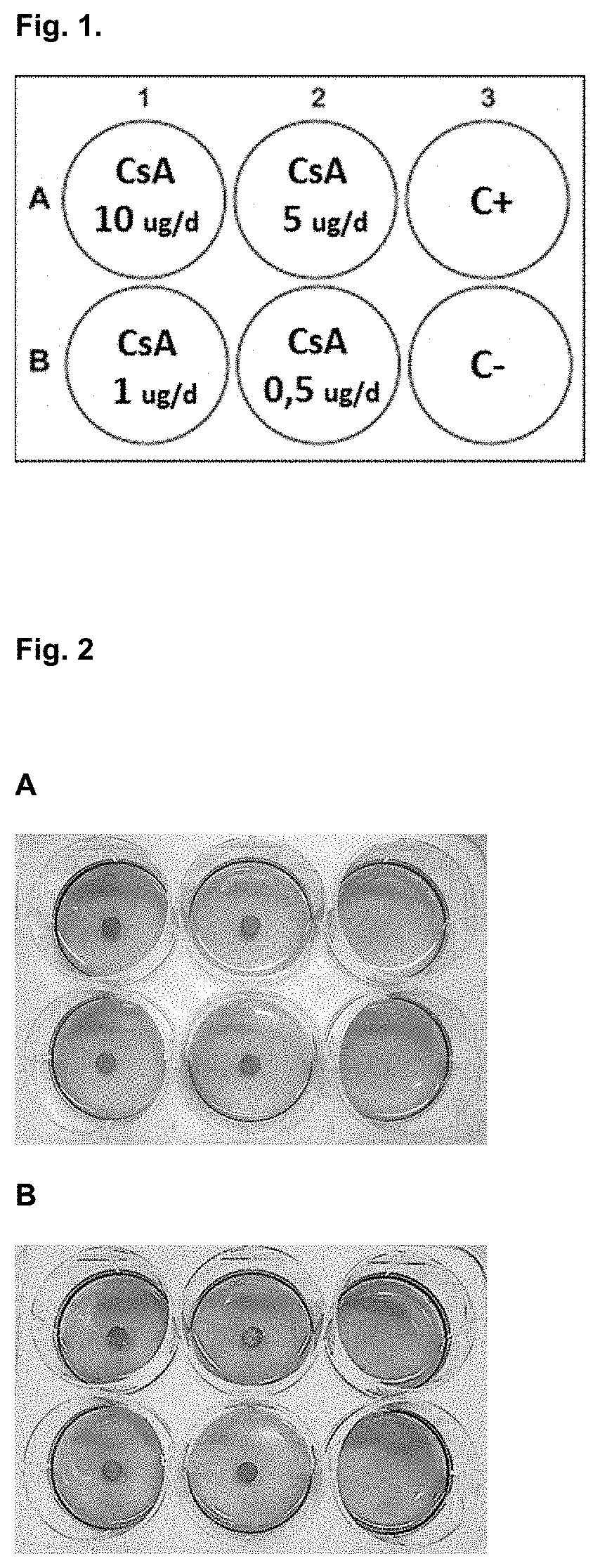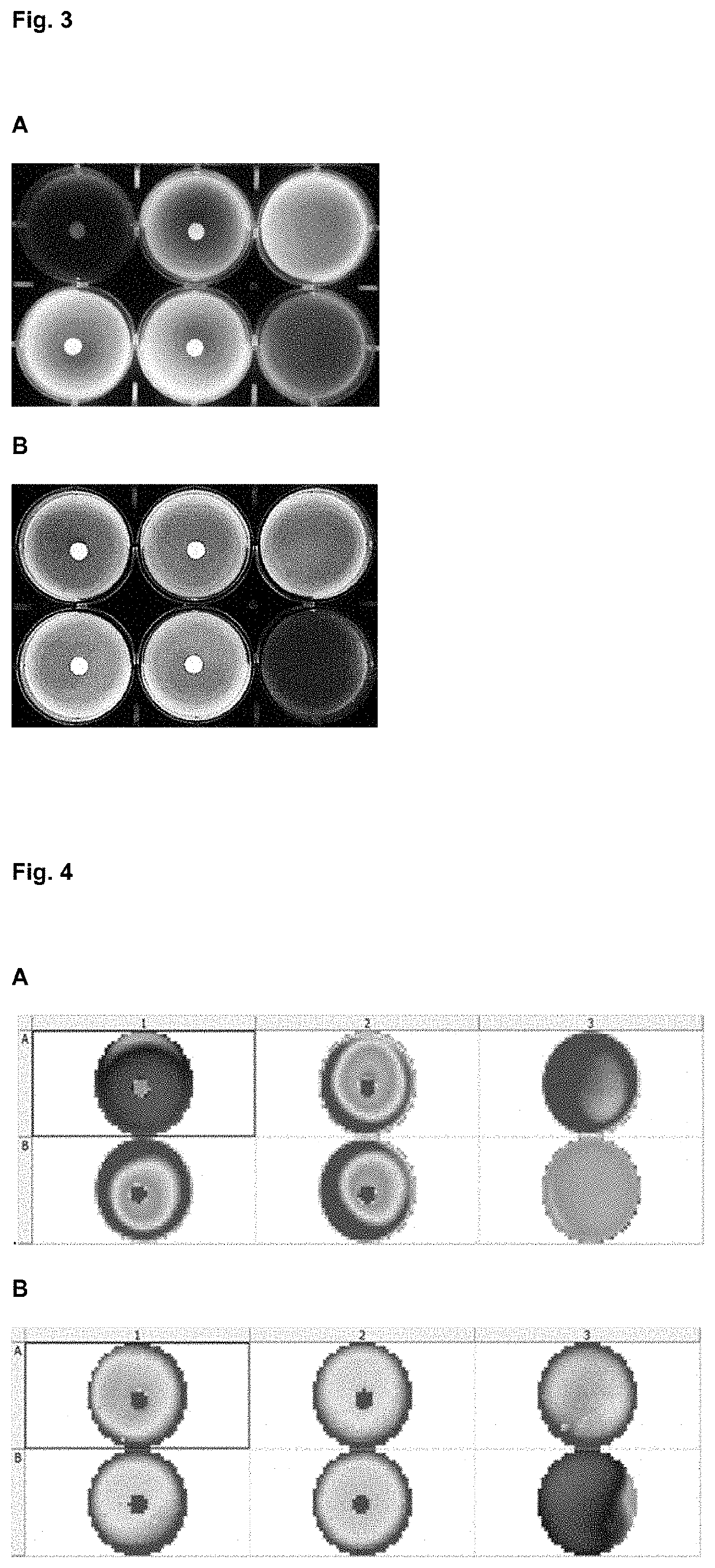Method for predicting and monitoring clinical response to immunomodulatory therapy
a clinical response and immunomodulatory therapy technology, applied in the field of immunomodulatory therapy prediction and monitoring clinical response, can solve the problems of inability to predict the efficacy/potency tool, the inability to predict the efficacy, and the inability to achieve the effect of reducing the risk of condition chronification and reducing the undesired side effects
- Summary
- Abstract
- Description
- Claims
- Application Information
AI Technical Summary
Benefits of technology
Problems solved by technology
Method used
Image
Examples
example 1
usion Assay in Semisolid Media (Agarose 0.5% and Collagen 0.3% Hydrogels)
[0207]Agarose and collagen polymeric hydrogels were prepared from concentrated stock (4% and 0.5% gr / 100 ml respectively) and diluted in cell culture medium to a final percentage of 0.5 and 0.3% gr / 100 ml respectively. Agarose stock requires previous melting at 70° C. and collagen stock requires manipulation at 4° C. till use to avoid premature gelation. Immune cells, previously isolated and counted, were immediately added and mix with the hydrogel solution at a concentration in the range of 5,00,000 cells / ml, generating homogeneous 3D cells dispersion. Both solutions became semisolid in a period of time that ranged from 30 to 90 minutes depending on temperature (RT or 37° C.) and polymer percentage. After gelation, discs with different Cyclosporine A contents were place in the centre of the wells over the hydrogel surface. After 24 hours of incubation at 37° C. and 0.5% of CO2 the resazurin solution (Presto Bl...
example 2
ve Between Different Semisolid Media
[0211]Different hydrogels compositions (agarose, methylcellulose, collagen and auto assembling peptides) and percentages where prepared in X-VIVO (Lonza) cell medium. Previously isolated PBMC (activated during 24 h with antiCD3-CD28: positive control and non-activated PBMCs: negative control) were immediately added to the hydrogel-cell medium mix at a concentration in the range of 500.000 cells / ml, generating homogeneous 3D cells dispersion. After proper time for allow gelation process (30 to 90 minutes) and additional incubation period 24 or 48 hours at 37° C. and 0.5% of CO2 the resazurin solution (Presto Blue®) was added in each well in a volumetric ratio of 1:10 and further incubated for 6-20 h. Activation window between activated and non-activated PBMC depends on time, hydrogel polymer chemical composition and stiffness, understood as a proportional parameter with the polymeric fraction percentage.
[0212]As illustrated in FIG. 7, hydrogels bas...
example 3
dia Dilution Methods in Microplate Format in the Context of Specific Proliferative Inhibition of Activated PBMCs
[0217]Human PBMC were extracted for Buffy coat bags from blood bank volunteer donation using density gradient centrifugation in adequate hydrophilic isosmotic polysaccharide solutions with a density of 1.077 g / ml (Pancoll, PAN BIOTECH GmbH or Ficoll, GE Healthcare) at 760 G during 20 minutes at RT. Cells were extracted with pipette from the gradient interphase and then washed in HBSS w / o Ca, Mg and Phenol red (Lonza), and resuspended in X-VIVO 15 (Lonza) medium. Obtained cells were frozen in cryovials with serum free medium (Profreeze-CDM, Lonza) DMSO (Sigma Aldrich) 7.5% and storage until use in liquid nitrogen.
[0218]A few days later, removed vials from liquid nitrogen were immediately thawed in a 37° C. water bath for 2 minutes. When cells were nearly completely thawed, vials were swipe with 70% ethanol in sterile hood. Vial content was diluted in 37° C. pre-warmed 10 ml...
PUM
 Login to View More
Login to View More Abstract
Description
Claims
Application Information
 Login to View More
Login to View More - R&D
- Intellectual Property
- Life Sciences
- Materials
- Tech Scout
- Unparalleled Data Quality
- Higher Quality Content
- 60% Fewer Hallucinations
Browse by: Latest US Patents, China's latest patents, Technical Efficacy Thesaurus, Application Domain, Technology Topic, Popular Technical Reports.
© 2025 PatSnap. All rights reserved.Legal|Privacy policy|Modern Slavery Act Transparency Statement|Sitemap|About US| Contact US: help@patsnap.com



